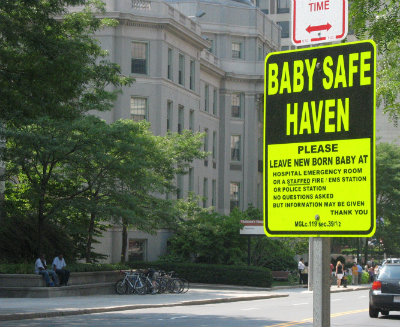Save haven laws spark debate over signage and promotion

This Safe Haven sign is located in Boston. Image from Wikipedia.
All fifty states have save haven laws that “decriminalize” the act of leaving a newborn, unharmed at a fire station or other designated area for up to seven days following the baby’s birth. Laws vary by state, but the general idea is that parents become immune from prosecution provided that they follow the letter of the law when leaving a baby. In most cases, the baby becomes a ward of the state.
Save haven laws were designed and enacted in order to discourage parents from harming or unsafely abandoning newborns that either aren’t wanted or can’t be properly cared for. Some advocates also support save haven laws because, in theory, they may cut down on demand for abortions.
Unfortunately, save haven laws can’t help if pregnant women and their partners don’t know that the law exists, or how the law works in a particular state. Officials in Indiana are currently searching for the mother of a newborn baby. The baby was left at a church and the person who left the baby there did not make an attempt to contact anyone in the church before simply leaving the baby. That course of action is not covered under Indiana’s safe haven law. Thus, the mother could face criminal charges related to “abandonment.”
Partly spurred by situations such as the one currently playing out in Indiana, supporters of save haven laws are discussing the signage currently used to designate save haven destinations and how the signage process could be adjusted in order to create more awareness of the laws and clarify the rules.
In its current iteration, a safe haven sign costs about $50, and the cost falls on the institution offering the safe haven. Many institutions don’t want to pay $50 for the sign. And it’s worth noting that the sign, which features the words “Safe haven” and an icon featuring an adult figure holding a baby, doesn’t include any clarifying details. This may have been why the person who left the newborn at the Indiana church did so without contacting anyone, since it may not have been clear that he or she needed to do so.
Tim Jaccard, a representative of Children of Hope and Safe Haven, emphasizes that $50 can be the difference between life and death. Jaccard hopes that Indiana will follow other state’s leads by investing in promotional programs to cover signage on behalf of safe haven destinations and create widespread awareness about the laws.
After a deceased newborn was found in a trash can in East Hartford, Connecticut, in 2014 a “coalition of state legislators pledged to develop a new promotional campaign” to push awareness of the state’s safe haven laws.
The safe haven program started in 1998, with the first official state law (dubbed the “Baby Moses law”) went into effect in Texas in 1999. According to Melissa Mahadeo of an Indiana ABC news affiliate, the safe haven program “has saved 3,007 babies.”
In spite of such a positive statistic, safe haven laws are not without detractors. Some critics of the laws argue that safe haven laws unfairly favor mothers (as suggested in the Alabama Civil Rights and Civil Liberties Law Review, in an oft-cited article written by Lisa Lucile Owens). The laws don’t require any particular reason to be offered by either parent dropping off a baby (e.g., there is no threshold for level of parental stress). That makes some people uncomfortable as it suggests that a momentary panic could lead to a lifetime of regret and subsequent court battles. And, in theory, one parent could “abandon” a baby via a safe haven law without the knowledge or approval of the other parent, which would mean more court battles.
Some states have temporary surrender laws that are aimed at parents who aren’t yet sure whether or not they want to give up their parental rights, and some detractors argue that the permanency of save haven laws “undercut” the temporary surrender laws.
Of course, court battles over safe haven laws don’t take place at all if parents don’t know about the law and choose a more violent route instead. Connecticut isn’t the only state in which officials have been moved to act following a tragedy. Alaska implemented a safe haven law in 2008, and five years later, it had still never been used. In spite of the presence of a state haven law, a very public case occurred in 2013 in which a mother abandoned her newborn in a park. The newborn died, and the mother was charged in the death. This case was part of what prompted Alaskan officials to launch a $20,000 campaign to raise awareness of the state’s safe haven laws.
While it’s rare to find a story from the perspective of a parent who took advantage of a save haven law, a 2014 article in the Galesburg, Illinois Register-Mail has a very different, and poignant, perspective from a 9-year-old who was given up via a safe haven law. “When I was born, my birth mother wasn’t ready to be a mom, but she loved me and she knew about safe haven,” she said. “So she took me to the hospital to be adopted. Now I have six brothers, two sisters, three dogs, and one cat. And they love me.”










